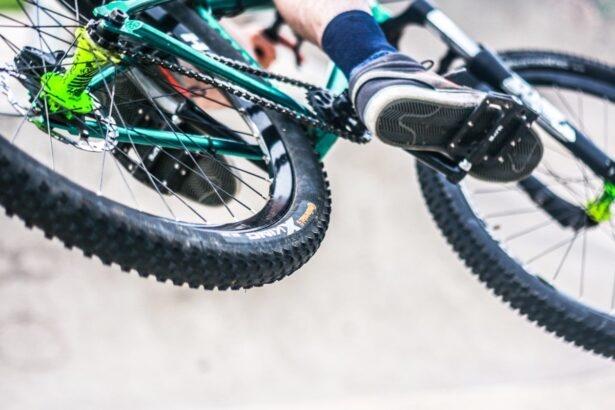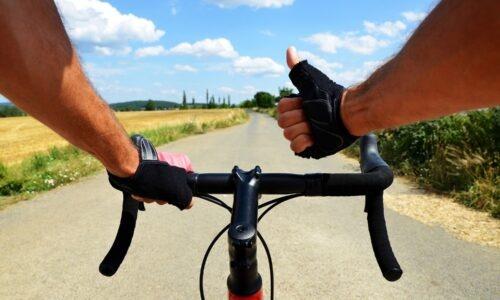Introduction
In the world of cycling, weight is one of the most important factors to consider no matter which type of cycling you’re going to be undertaking.
When we look at cycling weight there are three key areas to consider; the weight of the bike (which includes all the components), the weight of the rider and the weight of any of the baggage the rider wishes to carry whilst out riding.
It is possible to make wight savings across all three areas, however, today we are going to be focussing on the component parts, and in particular mountain bike pedals.
The significance of pedal weight in mountain biking

Weight can be a big issue in cycling and can impact a number of areas such as speed, efficiency, climbing, durability and handling. Cyclists are always out to try and make weight savings across their bike setup, but a fine balance needs to be struck between making these weight savings and using equipment that is enjoyable and suits your personal riding style.
In terms of mountain biking, where perhaps the sole focus isn’t just on speed, but rather tackling uneven and difficult terrain, opting for a more robust and heavier style of pedal may be beneficial due to these types of pedals having more durability.
Generally speaking, mountain bike pedals weight can range from 200g to 400g, so you can see even having the heaviest set of pedals on your bike won’t make the bike much heavier. If you also add into the scenario that the price can range from as cheap as under £50 up to over £300 then it’s easily possible to make weight savings elsewhere for much less cost.
For the average rider I would say that there are easier and more cost-effective ways to shed weight in other areas. You can easily look at what you’re carrying and remove any unnecessary items e.g. excess water bottles or perhaps any unwanted items from a bag. Alternatively, there could be larger weight savings to be made elsewhere on your bike setup.
Overview of MTB pedal types
Mountain bike pedals come in two main varieties, the flat pedal (sometimes known as the platform pedal) or what is called a ‘clipless’ pedal. The term ‘clipless’ can be confusing for those newer to cycling because if you choose this style of pedal it actually means that your foot will be clipped into the pedal via a cycling shoe and cleat.
Flat pedals
These come as standard with many new mountain bikes and are great for newer or inexperienced mountain bike riders. The design has evolved over the years and these types of pedals often feature more grip due to the fact they need to be used with ‘normal’ style trainers.
The main advantage of this type of pedal is that the rider has flexibility to remove their foot from the pedal at any time, without any trouble at all. Where these types of pedals have disadvantages to clipless pedals is that they don’t offer as much performance-related enhancements, and they can be slippier, especially in wet conditions.
Clipless pedals
These types of pedals are an upgrade in terms of performance and would be great for more experienced mountain bike riders. They offer great reliability, and the fact that your foot is connected to the pedal means you can generate much more power because you benefit from the full range of motion.
In terms of transitioning between the two types of pedals, it can be difficult to step up to clipless as they do require a bit of getting used to, especially disengaging your foot from the pedal, which is super important if you are heading for a crash. These pedals are also normally much lighter than flat pedals and you certainly benefit from not as much foot slippage whilst pedalling.
The contenders for the lightest MTB pedals
If you’ve got your heart set on upgrading your mountain bike pedals to one of the lightest options available, check out these options which could be everything that you’re looking for.
Let’s start with clipless pedals:
| Brand | Model | Key features | Price |
| Crankbrothers | Eggbeater 11 |
| |
| HT | T2-SX |
| |
| Xpedo | M-Force 8 |
| |
| Crankbrothers | Eggbeater 3 |
| |
| Look | X-TRACK Carbon MTB |
| |
| Time | Speciale 8 |
| |
| Look | X-TRACK MTB |
| |
| Shimano | XT M8120 |
| |
| Shimano | PD-M530 |
| |
| HT | X3 |
|
And now for the flat pedals:
| Brand | Model | Key features | Price |
| Dimension | Mountain pro pedals |
| |
| DMR | V6 |
| |
| Crankbrothers | Stamp 1 |
| |
| Race Face Chester |
| ||
| Crankbrothers | Stamp 7 |
| |
| Joystick Emulator |
| $160 | |
| DEITY | TMAC |
| £150 | $180 |
| PNW | Loam Alloy pedals |
| |
| Shimano Saint | PD-MX80 |
|
This is just a small selection of mountain bike pedals, but here I’ve provided you with a range of options at multiple price points, so you have the freedom to choose something that suits your budget and overall cycling needs.
As you will be able to see, in terms of weight, removing the Crankbrothers Eggbeater 11 which are by far the most expensive, there is not a lot of weight to be saved between many of the other choices.
User reviews and expert opinions
To help you with your decision process we thought it might be good to include some other user reviews of the pedals we’ve listed above, so you can hear from people who’ve used them.
We’re starting again with the clipless pedals.
| Brand | Model | Rating, reviews and expert opinions |
| Crankbrothers | Eggbeater 11 | 8/10 Excellent set of pedals, and if you can afford them, go for it, but for the more general cyclist there are plenty more budget friendly options out there. |
| HT | T2-SX | 8/10 I hadn’t come across these pedals before but from reading other reviews, I can see that feedback is very positive, with the main positive comments being in relation to price and weight. From those who have used these pedals, and their predecessors, the T1 and X2 they are reporting an improvement in performance whilst retaining the quality of the former pedals. |
| Xpedo | M-Force 8 | 6/10 I’ve come across a few other reviews of these pedals and whilst they are a good pedal, the price is on the high side compared to other options. Also, there is an 85kg weight limit on the ti spindles. On the positive side, due to their minimal design there is nowhere for the mud to get stuck. |
| Crankbrothers | Eggbeater 3 | 8/10 Amongst other review websites and user reviews, the general consensus these are a quality product, but due to being difficult to engage they wouldn’t be best suited for those of you who are just getting to grips with clipless pedals. On the other hand, if you are an experienced clipless pedals user, these excel in muddy conditions and are lightweight. |
| Look | X-TRACK Carbon MTB | 9/10 This pedal has some seriously good reviews amongst other reviewers, including those who have used the pedal. The general feedback is that is provides a stable and comfortable ride whilst being to use. What lets these pedals down slightly is their durability. |
| Time | Speciale 8 | 7/10 This has attracted quite a few positive reviews, with many saying it’s one of the best set of pedals produced in the series. There’s plenty to enjoy such as stability, great operation in muddy conditions and also a lightweight pedal. One of the negatives that has been picked up by users is the fact that pedal entry and exit isn’t the easiest and might take some getting used to. |
| Look | X-TRACK MTB | 4/5 The majority of reviews of these pedals have given them a 4- or 5-star rating. Other experts who have reviewed them have said similar things, with the majority of the positivity being directed at the price point. |
| Shimano | XT M8120 | 9/10 This one is a personal review as I’ve actually used these pedals and I’ve found them to be exceptional. I have to say one of the best set of pedals I’ve ever used – easy to use, durable and placed at a decent price point too. |
| Shiamno | PD-M530 | 8 /10 These pedals have received positive reviews from other experts and users. Everyone is saying that they offer great engagement and reliability, and at under £50 they also offer great value for money. |
| HT | X3 | 8/10
This is a very similar story to the HT T2-SX with these pedals receiving very positive reviews and being likened to their predecessors. |
And following up with the flat pedals.
| Brand | Model | Rating, reviews and expert opinions |
| Dimension | Mountain pro pedals | 5-star review on Amazon Obviously the first thing you notice about these pedals is the price and these are the cheapest set of flat pedals I’ve come across whilst writing this review. From the user reviews I’ve seen there’s only been positive feedback and if you’re someone who wants a cheap pair of flat pedals these would be the ones to choose. |
| DMR | V6 | 6/10 Whilst the price point of these pedals is favourable to many, the fact that other users are reporting durability issues and the fact that these pedals can’t be rebuilt might be a problem for some, especially if you’re tackling hardcore off-road routes. On the positive side these are a good choice for more gentle riding and for those with smaller feet. |
| Crankbrothers | Stamp 1 | 8 /10 For under £50 I don’t think you can go wrong with the Crankbrothers Stamp 1 pedals. I haven’t used them myself but I have friends who have and they’ve all said really positive things about them. They have great grip and are serviceable in case you need to rebuild them. |
| Race Face Chester | 5-star review on Amazon. Many users are reporting positive aspects to these pedals such as, the grip, the appearance, the price, durability and performance – an all-round excellent review for a cheap set of pedals. | |
| Crankbrothers | Stamp 7 | 8/10 The many positive aspects of these pedals include great grip, huge foot platform which provides additional stability, but on the downside, they are expensive compared to other pedals |
| Joystick Emulator | 7/10 I’ve looked at a number of other expert and user reviews and pretty much have all come to the same conclusion; these are a good pedal which offer everything you will need, but they are on the expensive side compared with other available options. | |
| DEITY | TMAC | 9/10 There’s huge positivity surrounding these pedals which might make you stretch to pay the extra money for them. I would think that if you’re doing mostly off-road trail riding it would be a good idea to invest in these pedals as they will offer you all the benefits you’ll need for great rides. |
| PNW | Loam Alloy pedals | 5/10 These are very conventional flat pedals that aren’t suited to serious off-road riding. Some of the negative comments include foot slippage, and overall, not a grippy pedal. On the positive side they do have good durability and come with a lifetime warranty. |
| Shimano Saint | PD-MX80 | 6/10 These have scored slightly worse than other pedals I’ve come across and whilst there’s nothing majorly wrong with them, for those concerned with saving weight they could be on the heavy side. Another negative aspect is the foot platform is quite small compared to other pedals. |
As you will be able to tell, choosing the right pedal depends on so many factors and there isn’t a one-size-fits-all approach, but this information will help you on your way to choosing the right pedal for your riding needs.
Factors to consider when choosing MTB pedals
| Area of consideration | Definitions and explanations |
| Clipless vs flat pedals | If you aren’t aware, clipless pedals are the style of pedal where your foot is attached to the pedal via a cleat. This is a different experience compared with a flat pedal where you have the freedom to remove your foot from the pedal at any stage. The clipless vs flat pedals is a matter of personal choice and dependent on if you feel confident to have your feet attached to the MTB pedal whilst out riding. The clipless pedal can bring benefits such as increased power, especially on the upward motion but do come with higher risks, such as not being able to dismount from the pedal, especially if you’re not used to using them. |
| Length of ride | Again, this is dependent on the number of long rides you’ll be doing. Generally, the longer the ride then it’s better to have clipless pedals as your legs will work more efficiently, however, you can suffer from what is called ‘foot hotspots’ (pressure applied to the same area of the foot for long periods) if you are newer to very long rides. I personally wouldn’t choose flat pedals for very long mountain bike rides, although they’re easier to remove your foot from the pedal you will lose out on efficient pedalling and a stable foot position over the course of many miles. |
| Durability | There shouldn’t be much difference in the durability of flat or clipless pedals, although a few factors determine how long they will last, such as amount of riding, conditions of riding (if you go out regularly in poorer weather then you’ll need to have a regular maintenance system in place), whether you encounter any bumps and crashes along the way (we hope not!), and what they’re made of. |
| Terrain | Where will you be riding and what kind of terrain will you be covering? Flatter and less bumpy terrain may only require flat pedals, but if you intend on riding plenty of hills and fast descents then perhaps having the stability of clipless pedals would suit you better. |
| Size | Generally speaking, clipless pedals are much smaller than flat pedals which could be important. If you’re thinking of descending narrow tracks then having a smaller pedal will reduce the chances of impact with your surroundings. |
Maintenance and care for lightweight pedals
Living in Wales where the weather is, how can we put it, quite wet for a lot of the year it’s been super-important over the years for me to engage in a thorough maintenance and care package for all elements of my bike, but especially the pedals.
In the early days it wasn’t something I gave a lot of thought to, but I quite quickly came to realise how important this aspect was, especially if I wanted my pedals to last.
These days I have a thorough maintenance and care routine for my pedals which looks like this:
| Job | Frequency | Reasons |
| Bike shop service | Annually | I take my bike to the bike shop every year without fail. I feel that it’s super important for the whole bike to be professionally checked and any parts upgraded when needed. |
| Bike pedal inspection | Before and after every ride | I tend to inspect my bike pedals before embarking on every ride to make sure there are no obvious signs of major damage. Taking 5 minutes to check them over is much better than getting stuck half way on a ride! |
| Bike pedal cleaning | After every ride | I clean my bike pedals after every ride, especially after wet and muddy rides – it’s amazing how much dirt can get caught up in them. Over the long run this will stop them attracting rust and help with their longevity. |
| General maintenance | Once a month | I spend an hour about once a month performing a full bike safety check and making sure it’s fit for purpose. This includes spraying the pedals with some waterproof lubricant to help against rust damage and keep everything working smoothly. |
Conclusion
We’ve provided you with all the information about mountain bike pedals, but the choice of which ones to use is entirely yours. There really isn’t a right or wrong type of pedal and it’s all about your preferences, how comfortable and experienced you are riding your bike, your budget, and the type of riding you’re regularly going to be doing.
The main thing to consider is to choose a type of pedal that will enhance your enjoyment of riding, help you to tackle the terrain more easily, make you feel safe, and will last long enough for you to consider it money well spent.

Mike is an experienced road cyclist and mountain biker and splits his time between the two disciplines. In his spare time he can often be found tackling the big hills and mountains of mid-Wales, attempting to beat his previous times




